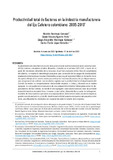Evolution of the total productivity of the factors in the manufacturing industry of The Coffee Area for the period 2005-2019
Productividad total de factores en la industria manufacturera del Eje Cafetero colombiano: 2005-2019
Compartir este ítem
Fecha
2023-07-14Autor
Restrepo-Carvajal, Nicolás
Aguirre-Peña, Daniel Steven
Manrique-Cabezas, Diego Alejandro
López-Ceballos, Carlos Evelio
Citación
Metadatos
Mostrar el registro completo del ítemDocumentos PDF
Resumen
This study describes the evolution of multifactorial productivity in the manufacturing sector of the Colombian coffee region (Caldas, Risaralda and Quindío) in the period 2005-2019 through a panel of microdata obtained from the Annual Manufacturing Survey (EAM). To meet the objective, the methodology proposed is used to correct simultaneity biases, using the demand for intermediate inputs as a proxy for productivity and gross capital formation, in addition to real wages to estimate the functions of production by departments that make up the coffee axis. The results suggest that productivity in the department of Quindío has had an unfavorable behavior with respect to Caldas and Risaralda in the aggregate sphere, which may be the consequence of a heterogeneous industrial composition between the departments of the coffee region, where the added value tends to concentrate on areas of intensive industrial activity in physical and human capital such as Caldas and Risaralda. On the other hand, the findings at the firm level show that there is a dissimilar behavior between Caldas, where large companies are more productive, and Quindío, where productivity increases in smaller companies; meanwhile, for Risaralda the results are consistent given the size of the company. El presente estudio describe la evolución de la productividad multifactorial en el sector manufacturero del Eje Cafetero colombiano (Caldas, Risaralda y Quindío) en el periodo 2005-2019, a través de un panel de microdatos obtenidos de la Encuesta Anual Manufacturera (EAM). Para el cumplimiento del objetivo, se emplea la metodología propuesta para corrección de los sesgos de simultaneidad, empleando la demanda por insumos intermedios como proxy de la productividad y la formación bruta de capital, además de los salarios reales para estimar las funciones de producción por departamentos que componen el eje cafetero. Los resultados sugieren que la productividad en el departamento del Quindío ha tenido un comportamiento desfavorable respecto a Caldas y Risaralda en el ámbito agregado, lo cual puede ser consecuencia de una composición industrial heterogénea entre los departamentos del Eje Cafetero, en donde el valor agregado suele concentrarse en zonas de actividad industrial intensivas en capital físico y humano, como Caldas y Risaralda. Por su parte, los hallazgos en el ámbito de firma muestran que existe un comportamiento disímil entre Caldas, donde las empresas grandes son más productivas, y Quindío, donde la productividad aumenta en empresas más pequeñas; entre tanto, para Risaralda los resultados son congruentes dado el tamaño de la empresa.


